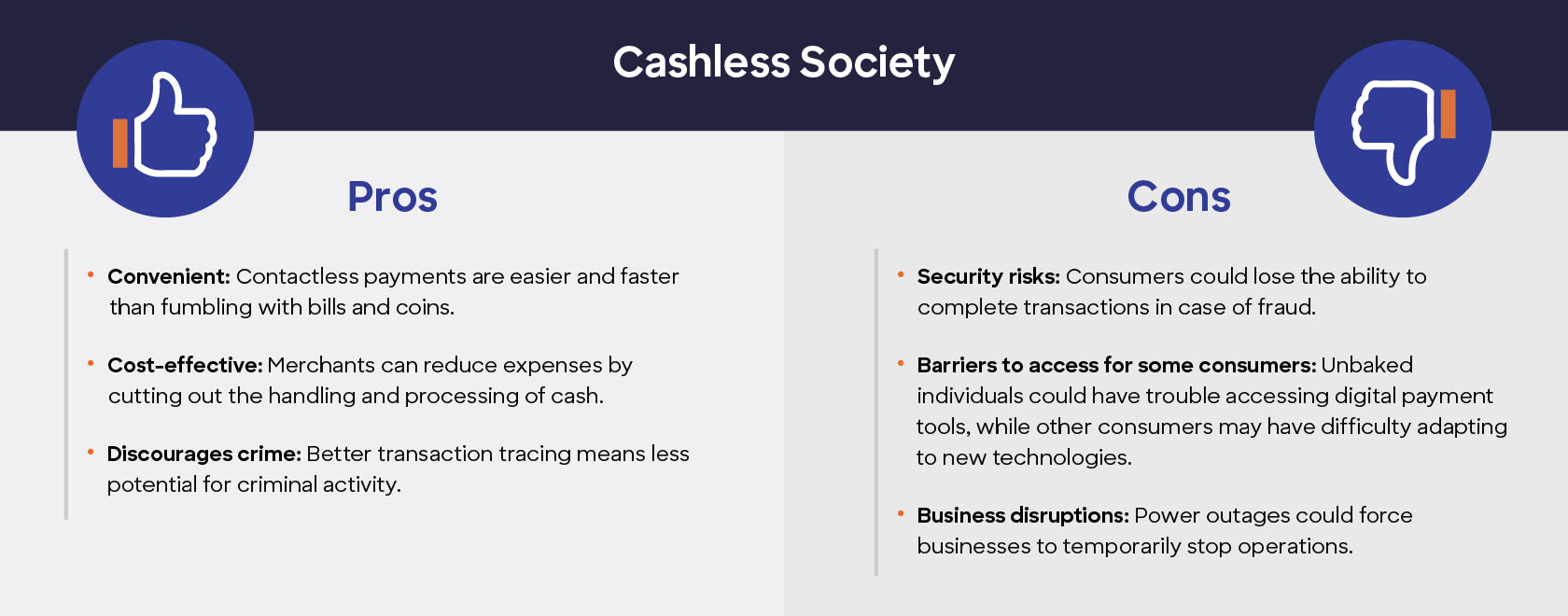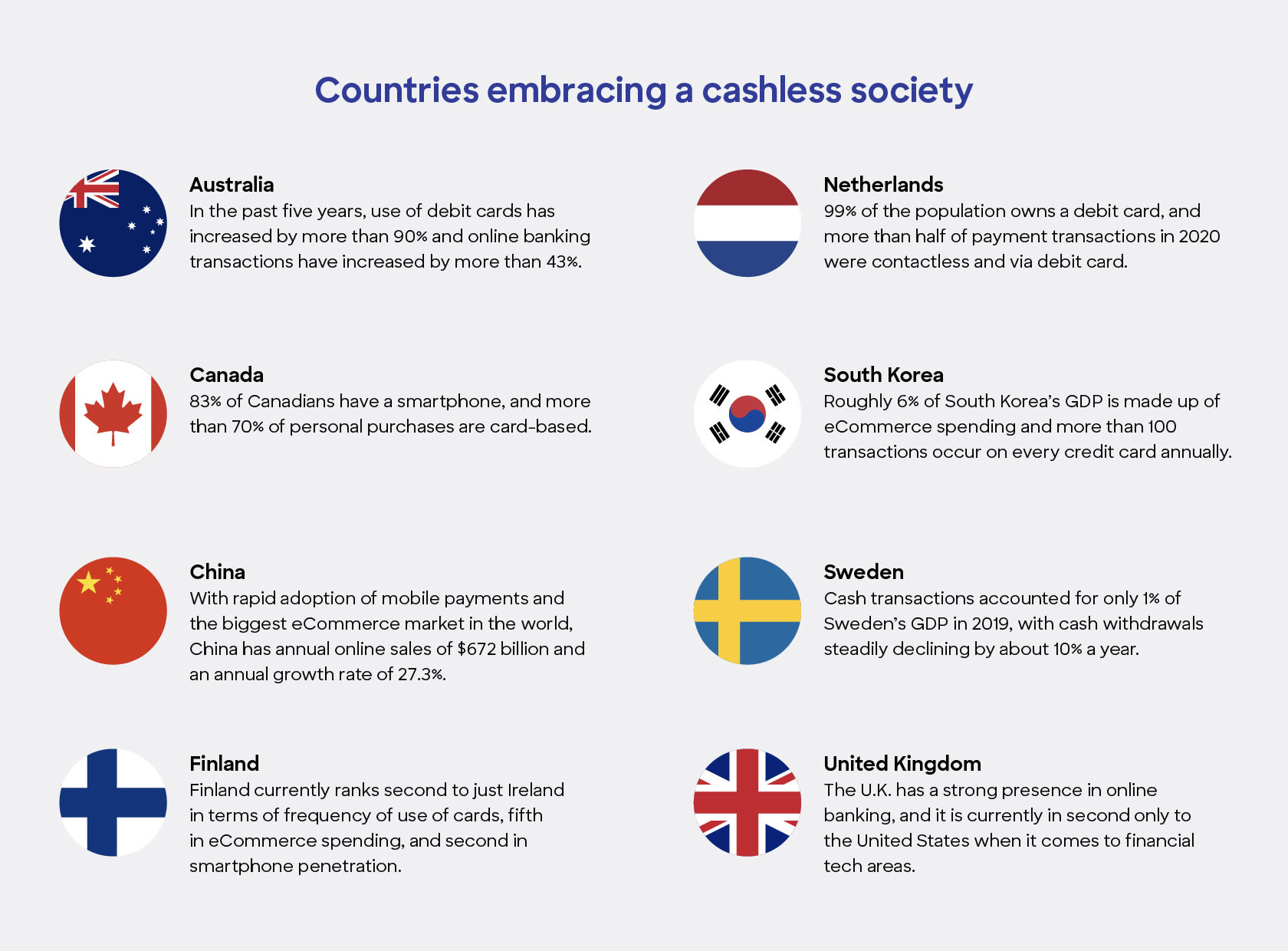The Cashless Society: What It Means for Merchants

The Cashless Society: What It Means for Merchants
The disappearance of cash—and the world’s full conversion to digital payments—has been forecast since the electronic transfer of funds was introduced in the ’60s. It then seemed inevitable by the time the internet came along in the ’80s.
Now, decades later, it may have finally arrived. Thanks to rapid advances in Fintech and blockchain, a much-anticipated cashless society is getting closer at hand.
The total transaction value of digital payments is on track to reach US$11.55tn in 2024 and the annual growth rate is expected to be 9.52%, which will result in it reaching US$16.59tn by 2028.1 In part, the growth of digital and cashless payments is due to consumers expecting convenience and speed, as well as due to technology advances expanding cashless/digital solutions.2
Additionally, landmark developments for digital and cashless payments have occurred over the past year, such as a new feature that lets an iPhone users move money from Apple Pay to another iPhone user’s Apple wallet in an instant.3
While a fully cashless economy doesn’t exist yet, many consumers and businesses are looking forward to the benefits it could bring—including easy cross-border payments, seamless transactions at the point of sale, and better transaction tracing.
What is a cashless economy?
Digital and contactless payments are more popular than ever. Consumers appreciate the convenience of shopping from anywhere, at any time, and paying with their method of choice—whether that’s a smartphone, contactless card, or wearable payment device. But a cashless society is one where bills and coins aren’t used at all. Instead, consumers purchase goods and services with a credit or debit card, mobile wallet, digital currency, or via electronic funds transfer, such as with electronic person-to-person (P2P) payments (e.g., Zelle, PayPal, Venmo, WeChat Pay, Alipay, and Cash App).
Pros and cons of a cashless society
For tech-savvy consumers and businesses looking to streamline their operations, the main advantage of a cashless society is convenience. Real-time payments made at the touch of a button beat fumbling with bills and coins for the time-pressed shopper and cost-minded merchant.
And now that smartphones have become payment terminals, even smaller merchants in emerging markets can benefit from digital payments. While they might not have traditional bank accounts, many of these merchants do have access to fast, frictionless tap on mobile technology installed on smartphones or tablets. In addition, cashless economies appeal to governments seeking to reduce tax avoidance and financial crime, as digital payments are more easily tracked than cash.
However, Discover and other industry organizations are proceeding cautiously—in part because there are important drawbacks that could come with eliminating cash altogether. Security risks are top-of-mind, as are barriers to access for the unbanked.
For example, consumers whose identities are stolen could find themselves without any purchasing power at all. Aside from security risks, some might have trouble adapting to the technologies required for cashless payments, like mobile wallets or QR codes. And in case of power outages, merchants could have trouble accepting payments—bringing the potential for significant disruptions to businesses and consumers alike.

The move to a cashless society varies by geography
While a cashless society is looking more plausible amid changing consumer attitudes and the advent of new payment technologies, progress around the globe is anything but uniform. Some markets, such as Sweden, the U.K., and several Asia-Pacific (APAC) countries, have adopted cashless payments in a relatively seamless manner.
Sweden was the first country to issue banknotes and is now one of the leading countries in mobile payment usage. Mobile payments account for 20% of the country’s transactions and only 1% are made with cash, which is largely due to the elderly population still using cash. Like Finland and Norway, 0% of Sweden’s population is unbanked.4
Although cash is still prominent in these areas, The Middle East, Africa, and Latin America are all regions where cashless payments have surged in the past two years.5 In many cases, cash continues to dominate in these developing markets due to a large proportion of unbanked and underserved individuals. Federal governments can encourage citizens to have a digital mindset that permeates into payments by offering free digital literacy programs, spreading awareness on the security digital payments provide, and working with private companies to explore solutions.5

Source: Corepay, May 2023. Cashless Societies: Which Countries Are Making the Switch? Viewed 14 August 2024.

The role of digital currencies in a cashless society
The Central Bank of Nigeria began phase two of the implementation process of eNaira in August 2022. This is Africa’s first digital currency. The motivation behind the rollout of eNaira was to improve financial inclusion, improve accountability of the informal sector, and facilitate remittances. It’s expected to increase financial inclusion from 64% to 95%.6
The People’s Bank of China began its e-CNY pilot in 2019, and by 2022, more than 260 million digital currency wallets had been opened. In May 2024, the program was expanded to Hong Kong. The e-CNY program was created to improve the efficiency of central bank payment systems, provide a back up to commercial retail systems, and promote financial inclusion.6
In 2020, Sweden launched a pilot project to simulate the workings of its digital currency, e-krona, in daily-life use cases in a controlled test environment and to study the effect of a CBDC on its economy. The EU has also accelerated work on a digital currency, while the U.S. Federal Reserve is signaling a potential role for a digital dollar, using blockchain technology.6
A cashless society is coming—the question is simply when
New technology has transformed many industries, and payments is no exception. Governments, Fintechs, banks, and merchants are all actively exploring opportunities to improve the payment experience, address the needs of unbanked individuals, and limit crime and corruption.
Moving toward a cashless society could be a vital part of the solution, but it’s critical that merchants stay informed—to minimize disruptions while maximizing the benefits of switching to purely digital transactions. For example, less regulatory oversight in this area currently leaves more room for identity theft, and even money laundering, than with traditional banking systems.
As a result, merchants and issuers must stay alert. Discover Global Network is here to help, which is why we’re working to develop the necessary governance, policies, and procedures to help ensure digital asset transactions can occur in a safe and secure manner.
Download Article
-
Statista, 2024. Digital Payments – Worldwide. Viewed 28 June 2024.
-
Finance Magnates, June 2023. The Cashless Society: A Paradigm Shift in Financial Transactions. Viewed 28 June 2024.
-
Payments Dive, June 2024. Apple unveils new iPhone touch and pay feature. Viewed 14 August 2024.
-
Expert Market, April 2024. What Are the Most Cashless Countries? Viewed 28 June 2024.
-
GovStack, August 2023. Embracing the Digital Era: How Governments Can Foster a Digital Mindset Among Residents. Viewed 28 June 2024.
-
Atlantic Council, May 2024. Central Bank Digital Currency Tracker. Viewed 14 August 2024.
The information provided herein is sponsored by Discover® Global Network. It is intended for informational purposes, and is not intended as a substitute for professional advice.